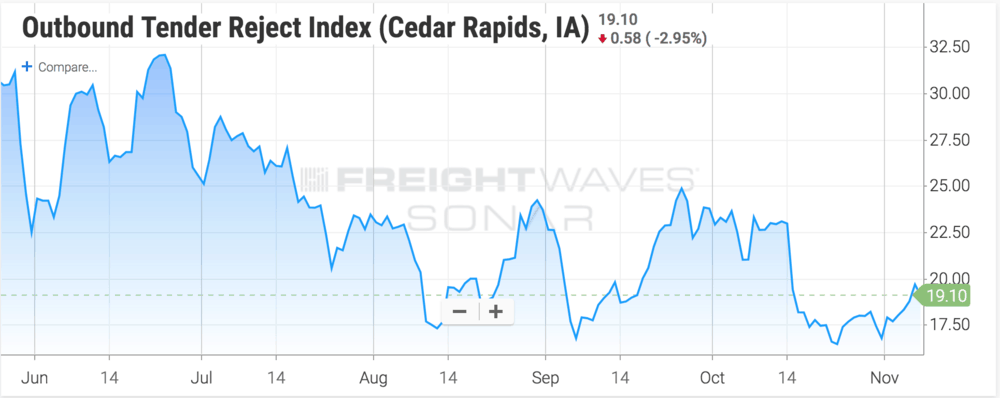Rail and truck demand a secondary casualty in trade dispute.
While U.S. inbound freight volumes may be a beneficiary of the U.S. and China trade war, the tariff fight is taking its toll on outbound freight at the peak shipping season for grain.
Speaking at an investor conference this week, Union Pacific (NYSE: UNP) chief financial officer Rob Knight said the railroad is seeing lower volumes of grain carloads in the fourth quarter. Not surprisingly, Knight attributed the slowdown to China’s imposition of 25% duties on U.S. soybean imports in July.
“Ag products continue to face uncertainty in the export markets due to tariffs,” Knight said. “We’re not seeing the normal seasonal ramp in agriculture exports.”
Knight did not give out specific figures on grain volumes in the fourth quarter. But railcar loading data compiled by Susquehanna Financial Group show a 19% drop in Union Pacific’s grain cargoes through the fourth quarter, one of the steepest drops among the Class 1 railroads.
Union Pacific’s view on agriculture carloads comes as the U.S. Department of Agriculture this week released data showing a 94% drop in soybean imports by China through the current marketing year.

Still, grain accounts for less than 4% of Union Pacific’s volume. The largest U.S. railroad by revenue is seeing overall volumes up 2% in the fourth quarter, led by industrial and intermodal growth.
The flipside to lower soybean exports has been a “pull-ahead” by shippers moving consumer and industrial goods into the U.S. ahead of 25% tariffs slated to start January 1.
But Union Pacific vice president and treasurer Jon Panzer said the railroad has not seen a pull-ahead “to any great extent” in its intermodal business.
“Our business has been strong, but we don’t anticipate a lot of it has been pull ahead,” Panzer said.
The drop off in soybean shipments is reverberating through the transportation industry. Jared Flinn, chief executive of Missouri-based bulk freight loadboard Bulkloads.com, says he has seen softer demand for grain-related truckload freight in the Midwest now as the current soybean harvest is being moved to market.
Farmers hire hopper trailers to bring soybeans, either to intermodal terminals or barge docks along the Mississippi, Ohio and Arkansas Rivers for trans-shipment to U.S. export gateways. But the U.S.D.A. said there’s been a 20% year-to-date drop in soybean shipments via barge.
“We have seen a decline in movement that would normally happen just because there’s not an outlet for these soybeans,” Flinn said.
Truck demand in the largest soybean producing regions in the U.S. show the effects of reduced movements. The outbound tender reject index for Cedar Rapids (SONAR: OTRI.CID), which covers the large soybean producing counties in eastern Iowa, remains near its year-to-date low.

Similar levels are being seen in the outbound tender reject index for Rock Island (SONAR: OTRI.MLI), which spans the soybean producing regions of western Illinois.

Farmers can also store soybeans in hopes of better markets down the line. But record high inventories of all types of grains means increasingly limited third-party storage capacity. Moreover, many farmers have built their own storage, limiting their need for short-haul shipments.
“We only have so much storage,” Flinn said. “We’re just getting to the point where these companies just don’t have a place to put it.”
To be sure, farmers are experiencing the worst of the tariffs as high inventories and low demand are forcing many of them to sell product at costs below breakeven, Flinn says.
“You have a lot of these farmers that are done harvesting and most of them are sitting in limbo wondering what the market holds for shipping out grains,” he said.










